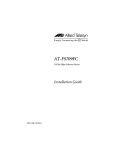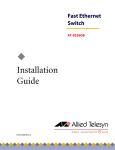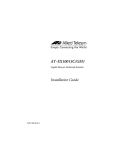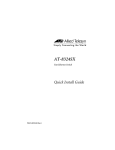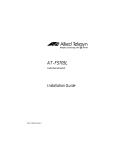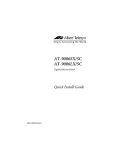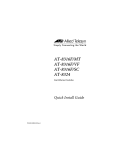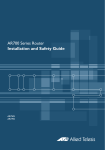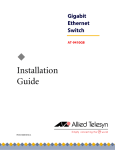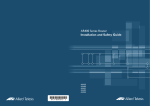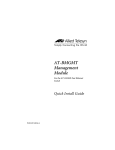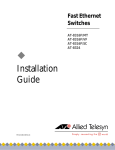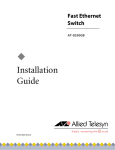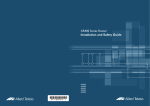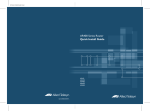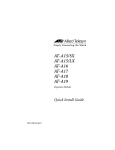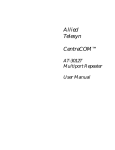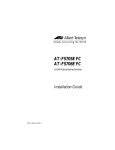Download Allied Telesis AT-RPS8000 Installation guide
Transcript
Gigabit Ethernet Switches AT-9006T AT-9006SX/SC AT-9006LX/SC ! Installation Guide PN 613-10851-00 Rev B ® Copyright 2000 Allied Telesyn International, Corp. 960 Stewart Drive Suite B, Sunnyvale, CA 94085 USA All rights reserved. No part of this publication may be reproduced without prior written permission from Allied Telesyn International, Corp. CentreCom is a registered trademark of Allied Telesyn International, Corp. All other product names, company names, logos or other designations mentioned herein are trademarks or registered trademarks of their respective owners. Allied Telesyn International, Corp. reserves the right to make changes in specifications and other information contained in this document without prior written notice. The information provided herein is subject to change without notice. In no event shall Allied Telesyn International, Corp. be liable for any incidental, special, indirect, or consequential damages whatsoever, including but not limited to lost profits, arising out of or related to this manual or the information contained herein, even if Allied Telesyn International, Corp. has been advised of, known, or should have known, the possibility of such damages. Electrical Safety and Emission Statement Standards: This product meets the following standards. U.S. Federal Communications Commission RADIATED ENERGY Note: This equipment has been tested and found to comply with the limits for a Class A digital device pursuant to Part 15 of the FCC Rules. These limits are designed to provide reasonable protection against harmful interference when the equipment is operated in a commercial environment. This equipment generates, uses, and can radiate radio frequency energy and, if not installed and used in accordance with this instruction manual, may cause harmful interference to radio communications. Operation of this equipment in a residential area is likely to cause harmful interference in which case the user will be required to correct the interference at his own expense. Note: Modifications or changes not expressly approved by the manufacturer or the FCC can void your right to operate this equipment. Canadian Department of Communications This Class A digital apparatus meets all requirements of the Canadian Interference-Causing Equipment Regulations. Cet appareil numérique de la classe A respecte toutes les exigences du Règlement sur le matériel brouilleur du Canada. RFI Emission EN55022 Class A " 1 Warning: In a domestic environment this product may cause radio interference in which case the user may be required to take adequate measures. " 2 Immunity EN50082-1 1997 " 3 Electrical Safety EN60950, UL 1950, CSA 950 " 4 Laser EN60825 " 5 Important: Appendix C contains translated safety statements for installing this equipment. When you see the ", go to Appendix C for the translated safety statement in your language. Wichtig: Anhang C enthält übersetzte Sicherheitshinweise für die Installation dieses Geräts. Wenn Sie " sehen, schlagen Sie in Anhang C den übersetzten Sicherheitshinweis in Ihrer Sprache nach. Vigtigt: Tillæg C indeholder oversatte sikkerhedsadvarsler, der vedrører installation af dette udstyr. Når De ser symbolet ", skal De slå op i tillæg C og finde de oversatte sikkerhedsadvarsler i Deres eget sprog. Belangrijk: Appendix C bevat vertaalde veiligheidsopmerkingen voor het installeren van deze apparatuur. Wanneer u de " ziet, raadpleeg Appendix C voor vertaalde veiligheidsinstructies in uw taal. Important : L'annexe C contient les instructions de sécurité relatives à l'installation de cet équipement. Lorsque vous voyez le symbole ", reportez-vous à l'annexe C pour consulter la traduction de ces instructions dans votre langue. Tärkeää: Liite C sisältää tämän laitteen asentamiseen liittyvät käännetyt turvaohjeet. Kun näet "-symbolin, katso käännettyä turvaohjetta liitteestä C. Importante: l’Appendice C contiene avvisi di sicurezza tradotti per l’installazione di questa apparecchiatura. Il simbolo ", indica di consultare l’Appendice C per l’avviso di sicurezza nella propria lingua. Viktig: Tillegg C inneholder oversatt sikkerhetsinformasjon for installering av dette utstyret. Når du ser ", åpner du til Tillegg C for å finne den oversatte sikkerhetsinformasjonen på ønsket språk. Importante: O Anexo C contém advertências de segurança traduzidas para instalar este equipamento. Quando vir o símbolo ", leia a advertência de segurança traduzida no seu idioma no Anexo C. Importante: El Apéndice C contiene mensajes de seguridad traducidos para la instalación de este equipo. Cuando vea el símbolo ", vaya al Apéndice C para ver el mensaje de seguridad traducido a su idioma. Obs! Bilaga C innehåller översatta säkerhetsmeddelanden avseende installationen av denna utrustning. När du ser ", skall du gå till Bilaga C för att läsa det översatta säkerhetsmeddelandet på ditt språk. iii Table of Contents Table of Contents ................................................................................................................................................................................................. 5 Preface ...................................................................................................................................................................................................................... 7 Audience ................................................................................................................................................................................................................... 7 How This Guide is Organized ............................................................................................................................................................................. 7 Document Conventions ...................................................................................................................................................................................... 8 Where to Find Web-based Guides ................................................................................................................................................................... 9 Contacting Allied Telesyn .................................................................................................................................................................................10 Online Support ............................................................................................................................................................................................. 10 Telephone and Fax Support .................................................................................................................................................................... 10 E-mail Support.............................................................................................................................................................................................. 10 Returning Products .............................................................................................................................................................................................11 FTP Server ...............................................................................................................................................................................................................12 For Sales or Corporate Information ...............................................................................................................................................................13 Tell Us What You Think ......................................................................................................................................................................................14 Chapter 1 Product Description .........................................................................................................................................................................................15 Summary of Features ..........................................................................................................................................................................................16 Switch Models .......................................................................................................................................................................................................17 Features and Components ...............................................................................................................................................................................18 Six Twisted Pair 100/1000 Mbps Ports (AT-9006T).......................................................................................................................... 18 Six Fiber Optic 1000 Mbps Ports (AT-9006SX/SC and AT-9006LX/SC) ..................................................................................... 19 RS232 Connector ......................................................................................................................................................................................... 19 System and Port LEDs ................................................................................................................................................................................ 19 Reset Button.................................................................................................................................................................................................. 20 AC Power Connector.................................................................................................................................................................................. 20 Redundant Power Supply Connector .................................................................................................................................................. 20 Expansion Slots ............................................................................................................................................................................................ 21 MAC Address Table..................................................................................................................................................................................... 21 AT-S26 Management Software and Omega Management Interface ....................................................................................... 22 IEEE 802.3u Auto-Negotiation ................................................................................................................................................................ 23 Spanning Tree Protocol (STP) ................................................................................................................................................................. 23 Quality of Service (QOS)............................................................................................................................................................................ 24 BOOTP and Dynamic Host Configuration Protocol (DHCP) ......................................................................................................... 25 Port Mirroring ............................................................................................................................................................................................... 25 Virtual LANs (VLANs) .................................................................................................................................................................................. 25 Network Topologies ............................................................................................................................................................................................27 Where to Go Next .................................................................................................................................................................................................28 5 Table of Contents Chapter 2 Installation ........................................................................................................................................................................................................... 29 Verifying the Package Contents ..................................................................................................................................................................... 30 Reviewing Safety Precautions ......................................................................................................................................................................... 31 Selecting a Site for the Switch ........................................................................................................................................................................ 32 Planning the Installation ................................................................................................................................................................................... 33 Installing the Switch on a Desktop ............................................................................................................................................................... 34 Installing the Switch in a Rack ........................................................................................................................................................................ 36 Installing an Expansion Module ..................................................................................................................................................................... 38 Starting a Local Omega Management Session ......................................................................................................................................... 41 Warranty Registration ........................................................................................................................................................................................ 42 Where to Go Next ................................................................................................................................................................................................ 43 Chapter 3 Troubleshooting ................................................................................................................................................................................................ 45 At the First Sign of a Problem ......................................................................................................................................................................... 46 How the Switch Reports Problems ................................................................................................................................................................ 47 Common Problems ............................................................................................................................................................................................. 48 Link /Activity LED on Any Port is OFF .................................................................................................................................................. 48 Power LED is OFF ........................................................................................................................................................................................ 48 Fault LED is ON ............................................................................................................................................................................................ 49 Calling Technical Support ................................................................................................................................................................................ 50 Appendix A Technical Specifications ................................................................................................................................................................................ 51 Physical Specifications ....................................................................................................................................................................................... 51 Dimensions ................................................................................................................................................................................................... 51 Weight ............................................................................................................................................................................................................ 51 Required Ventilation on All Sides.......................................................................................................................................................... 51 Environmental Specifications ......................................................................................................................................................................... 52 Operating Temperature ........................................................................................................................................................................... 52 Storage Temperature ................................................................................................................................................................................ 52 Operating Humidity................................................................................................................................................................................... 52 Operating Altitude Range........................................................................................................................................................................ 52 Power Specifications .......................................................................................................................................................................................... 53 Maximum Power Consumption ............................................................................................................................................................ 53 AC Input Voltage......................................................................................................................................................................................... 53 Frequency...................................................................................................................................................................................................... 53 DC Redundant Power Voltage ............................................................................................................................................................... 53 Safety and Electromagnetic Emissions Certifications ............................................................................................................................ 54 Safety............................................................................................................................................................................................................... 54 EMI.................................................................................................................................................................................................................... 54 Immunity ....................................................................................................................................................................................................... 54 Quality and Reliability ............................................................................................................................................................................... 54 Pin Assignment .................................................................................................................................................................................................... 55 Appendix B Switch Default Settings .................................................................................................................................................................................. 57 Appendix C Translated Electrical Safety and Emission Information ................................................................................................................. 59 6 Preface This guide contains instructions on how to install the AT-9006T, AT-9006SX/SC, and AT-9006LX/SC Gigabit Ethernet Switches. Audience This guide is intended for network administrators who are responsible for installing and managing the switches. Network administrators should be familiar with Ethernet switches, Ethernet and Fast Ethernet technology, bridging, and the Spanning Tree Protocol (STP). How This Guide is Organized This manual contains the following chapters and appendices: Chapter 1, Hardware Description, describes the features and components of the Gigabit switches. Chapter 2, Installation, contains the installation procedures. Chapter 3, Troubleshooting, provides information on how to resolve common problems that might occur with the switches. Appendix A, Technical Specifications, contains the specifications of the switches. Appendix B, Switch Default Settings, lists the factory default settings for the switch. Appendix C, Translated Electrical Safety and Emission Information, contains translations of the warnings and cautions in the manual. 7 Preface Document Conventions This document uses several conventions that you should become familiar with before you begin to install the product. Note Notes provide additional information. Warning Warnings inform you that performing or omitting a specific action may result in bodily injury. Caution Cautions inform you that performing or omitting a specific action may result in equipment damage or loss of data. 8 AT-9006 Series Installation Guide Where to Find Web-based Guides The Allied Telesyn web site at www.alliedtelesyn.com offers you an easy way to access the most recent documentation and technical information for all Allied Telesyn International products. All web-based documentation for this product and other Allied Telesyn products can be downloaded from the web site in PDF format. You will need the following manual in addition to this guide in order to manage the Gigabit Ethernet switch. The manual contains instructions on how to use the AT-S26 management software to manage and configure the switch. The manual is available from the Allied Telesyn web site: ❑ AT-S26 Management Software User’s Guide, PN 613-10852-00 9 Preface Contacting Allied Telesyn There are several ways that you can contact Allied Telesyn technical support: online, telephone, fax and e-mail. Online Support Telephone and Fax Support E-mail Support You can request technical support online by filling out the Online Technical Support Form at www.alliedtelesyn.com/forms/support.htm. Americas United States, Canada, Mexico, Central America, South America Tel: 1 (800) 428-4835, option 4 Fax: 1 (503) 639-3176 Germany Germany, Switzerland, Austria, Eastern Europe Tel: (+49) 0130/83-56-66 Fax: (+49) 30-435-900-115 Asia Singapore, Taiwan, Thailand, Malaysia, Indonesia, Korea, Philippines, China, India, Hong Kong Tel: (+65) 381-5612 Fax: (+65) 383-3830 Italy Italy, Spain, Portugal, Greece, Turkey, Israel Tel: (+39) 02-41-30-41 Fax: (+39) 02-41-30-42-00 Australia Tel: 1 (800) 000-880 Fax: (+61) 2-9438-4966 Japan Tel: (+81) 3-3443-5640 Fax: (+81) 3-3443-2443 France France, Belgium, Luxembourg, The Netherlands, Middle East, Africa Tel: (+33) 0-1-60-92-15-25 Fax: (+33) 0-1-69-28-37-49 United Kingdom United Kingdom, Denmark, Norway, Sweden, Finland Tel: (+0044) 1235-442500 Fax: (+44) 1-235-442680 United States and Canada [email protected] Latin America, Mexico, Puerto Rico, Caribbean, and Virgin Islands [email protected] United Kingdom, Sweden, Norway, Denmark, and Finland [email protected] 10 AT-9006 Series Installation Guide Returning Products Products for return or repair must first be assigned a Return Materials Authorization (RMA) number. A product sent to Allied Telesyn without a RMA number will be returned to the sender at the sender’s expense. To obtain an RMA number, contact Allied Telesyn’s Technical Support at one of the following locations: North America 2124 Zanker road San Jose, CA 95131 Tel: 1-800-428-4835, option 4 Fax: 1-503-639-3716 European Customer Support Centre 10/11 Bridgemead Close Westmead Industrial Estate Swindon, Wiltshire SN5 7YT England Tel: +44-1793-501401 Fax: +44-1793-431099 Mexico and Puerto Rico Latin America, the Caribbean, Virgin Islands Tel: 1-800-424-5012, ext 3852 or Tel: international code + 425-481-3852 1-800-424-4284, ext 3852 Fax: international code + 425-483-9458 Mexico only: 95-800-424-5012, ext 3852 Fax: international code + 425-489-9191 11 Preface FTP Server If you need management software for an Allied Telesyn device and you know the name of the management software file, you can download the software by connecting directly to our FTP server at ftp://gateway.centre.com. At login, enter ‘anonymous’. Enter your e-mail address for the password as requested by the server at login. 12 AT-9006 Series Installation Guide For Sales or Corporate Information Allied Telesyn International, Corp. 19800 North Creek Parkway, Suite 200 Bothell, WA 98011 Tel: 1 (425) 487-8880 Fax: 1 (425) 489-9191 Allied Telesyn International, Corp. 960 Stewart Drive, Suite B Sunnyvale, CA 94085 Tel: 1 (800) 424-4284 (USA and Canada) Fax: 1 (408) 736-0100 13 Preface Tell Us What You Think If you have any comments or suggestions on how we might improve this or other Allied Telesyn documents, please fill out the Send Us Feedback Form at www.alliedtelesyn.com/forms/feedback.htm. 14 Chapter 1 Product Description The AT-9006 Series Gigabit Ethernet Switches allow you to build a flexible network topology suited to the demands of your network environment. The switches provide non-blocking architecture and fullwire speed performance on all ports. They can serve as high speed workgroup switches with dedicated links to workstations, printers, and servers, or as links to additional hubs and switches to form a high speed infrastructure for large networks. The switches offer a wide range of features, including IEEE 803.3u Auto-Negotiation, spanning tree protocol, and IEEE 802.1p Quality of Service. The switches are also IEEE 802.1Q compliant and support both port-based and tagged VLANs. 15 Product Description Summary of Features # Six 100Base-T/1000Base-TX ports with RJ-45 connectors (AT-9006T) # Six 1000Base-SX ports with dual SC connectors (AT-9006SX/SC) # Six 1000Base-LX ports with dual SC connectors (AT-9006LX/SC) # 12 K MAC address table with automatic aging # 2 MB SGRAM packet memory per port # 3 MB flash memory for software upgrades # 1.5u high chassis # Port trunking # Port mirroring # BOOTP and DHCP support # AT-S26 management software # Omega management interface # IEEE 803.3u Auto-Negotiation # Spanning tree protocol # IEEE 802.1p Quality of Service # IEEE 802.1Q compliant tagged VLANs # Two packet priority queues 16 AT-9006 Series Installation Guide Switch Models Table 1 lists the switch models. Table 1 AT-9006 Series Switches Model1 Number of Ports Type of Connector Maximum Distance AT-9006T 6 100Base-T / 1000Base-TX RJ-45 100 m (328 ft) AT-9006SX/SC 6 1000Base-SX Dual SC 550 m (1804 ft)2 AT-9006LX/SC 6 1000Base-LX Dual SC 10 km (6.25 mi)3 Type of Port 1. All models include two expansion slots. 2. Assumes 50/125 micron fiber optic cable with a rating of 500 MHz/Km. 3. Assumes 9/125 micron single-mode fiber optic cable. Also assumes the port is connected to another AT-9006LX/SX switch or to a compatible GBIC module. 17 Product Description Features and Components Figure 1 illustrates the front panel components. Expansion Module Slots Reset Button Port LEDs LED Color Function Key Fault LED AT-9006SX/SC 1000BASE-SX GIGABIT ETHERNET SWITCH 1000BASE-SX 1 PORT ACTIVITY 2 3 L /A L /A RS-232 TERMINAL PORT STATUS L /A A TX RX D/C TX 4 RX D/C TX 5 RX D/C CLASS 1 LASER PRODUCT DO NOT STARE INTO BEAM L /A L /A D/C 6 L /A LINK ACTIVITY FULL DUP HALF DUP COL FAULT L /A RPS B PWR TX RX D/C TX RX D/C TX RX D/C RESET 1000Base-SX ports RPS LED RS232 Connector Power LED Figure 1 Front Panel (Model AT-9006SX/SC) Figure 2 shows the location of the AC connector and the Redundant Power Supply (RPS) input connector on the back panel of the switch. AC Power Connector RPS Connector Figure 2 Back Panel Six Twisted Pair 100/1000 Mbps Ports (AT-9006T) The AT-9006T Gigabit Ethernet Switch features six twisted pair ports with RJ-45 connectors. Each port can operate at either 100 Mbps or 1000 Mbps and, when operating at 100 Mbps, in either half- or full-duplex mode. You can either set the speed and duplex mode manually or you can allow the switch to do it automatically through auto-negotiation. Each port has a maximum operating distance of 100 m (328 ft.). The switch requires Category 5 or Enhanced Category 5 twisted pair cabling. Each port is IEEE 802.3ab compatible and can operate as either MDI or MDI-X. The ports are configured automatically when connected to an end node. No crossover cables are required. 18 AT-9006 Series Installation Guide Six Fiber Optic 1000 Mbps Ports (AT-9006SX/SC and AT-9006LX/SC) The AT-9006SX/SC and AT-9006LX/SC Gigabit Ethernet Switches feature six fiber optic ports with dual SC connectors. The ports operate at 1000 Mbps in full-duplex mode. (The ports can be configured as half-duplex, but since all 1000 Mbps network devices operate at full-duplex, there should be no reason to set one of the ports to half-duplex.) RS232 Connector The RS232, DB-9 female connector provides out-of-band local management for the switch. You can use either a VT100 terminal or a personal computer with a terminal emulation program to connect to the RS232 port. The connector uses a straight-through cable. System and Port LEDs The switch features a series of system and port LEDs that you can use to monitor and troubleshoot the switch. Table 2 describes the system LEDs. Each port on the AT-9006SX/SC Switch has a maximum operating distance of 550 meters using multimode fiber optic cabling. The ports on the AT-9006LX/SC offer a maximum operating distance of 550 m using multimode cabling or 2 km using single-mode fiber optic cabling. Table 2 System LEDs LED State Description Fault OFF Normal operation. Solid Red The switch or management software is malfunctioning. Flashing Red The switch is booting, running diagnostic tests, writing messages to FLASH, or transferring files using XMODEM. RPS Solid Green An RPS is connected to the switch. To verify that the RPS is operating correctly, refer to your RPS manual. (AT-9006SX/ SC and AT-9006LX/SC only.) Power Solid Green The switch is receiving power. 19 Product Description Table 3 describes the port LEDs. Table 3 Port LEDs LED State Description Link/Activity Solid Green This indicates a 1000 Mbps link has been established between the port and the end node. Flashing Green This indicates 1000 Mbps activity on the port. Solid Amber This indicates a 100 Mbps link has been established between the port and the end node (AT-9006T only). Flashing Amber This indicates 100 Mbps activity on the port (AT-9006T only). Solid Green The port is operating in full-duplex mode. Solid Amber The port is operating at half-duplex mode (AT9006T only). Flashing Amber Collisions are occurring on the line (AT-9006T only). Duplex Reset Button AC Power Connector Redundant Power Supply Connector This button resets the switch. You might need to reset the switch to resolve a switch problem, to activate new parameters on the switch or to reset the switch statistics stored by the AT-S26 management software. You can also reset the switch using the Omega management interface, as explained in the AT-S26 Management Software User’s Guide. The switch has a single AC power supply socket on the back panel, which has autoswitch AC inputs. Refer to Appendix A, Technical Specifications, for the input voltage range. The power cord acts as an ON/OFF switch. The R.P.S. Input connector on the back panel of the AT-9006SX/SC and AT-9006LX/SC Switches connects the units to a redundant power supply (RPS), such as the AT-RPS8000 Redundant Power Supply from Allied Telesyn. Contact your Allied Telesyn representative for more information on available RPS units. Note The AT-9006T Switch does not support an RPS unit. 20 AT-9006 Series Installation Guide Expansion Slots The switch features two expansion slots on the front panel. You can use the slots to install optional expansion modules which you can use to extend the distance of your network, build high-speed backbone networks, and connect additional nodes to the network, such as highspeed servers. Note For a list of the Allied Telesyn expansion modules supported by your AT-9006 Gigabit Ethernet Switch and the AT-S26 management software, refer to the Preface in the AT-S26 Management Software User’s Guide. This guide is available from the Allied Telesyn web site. MAC Address Table The AT-9006 Series Switch contains a 12 K MAC address table. The switch uses the table to store the MAC addresses of the network nodes connected to its ports, along with the port number on which each address was learned. The switch learns the MAC addresses by examining the source address in each packet that enters a port, and adds the address and port to the MAC table, assuming the address has not already been entered in the table. When the switch receives a packet, it examines the destination address and, by referring to its MAC address table, can determine the port on which the destination node is connected. It then forwards the packet to the appropriate port and on to the end node. This increases network bandwidth by limiting each frame to the appropriate port when the intended end node is located, which frees the other switch ports for receiving and transmitting data. If the switch receives a packet with a destination address that is not in the MAC address table, it floods the packet to all the ports on the switch. If the ports have been grouped into virtual LANs, the switch floods the packet only to those ports which belong to the same VLAN as the port on which the packet was received. This prevents packets from being forwarded onto inappropriate LAN segments, increasing network security. When the destination node responds, the switch add its MAC address and port number to the table. If the switch receives a packet with a destination address that is on the same port on which the packet was received, it filters the packet and does not forward it on to any port. Since both the source node and the destination node for the packet are located on the same port on the switch, there is no reason for the switch to forward the packet. 21 Product Description AT-S26 Management Software and Omega Management Interface Included with the switch is the AT-S26 management software. You use this pre-installed software to manage the switch’s operating parameters, view port and switch status information, and monitor performance statistics. Included with the management software is the Omega management interface. This interface consists of a series of menus and prompts that make it easy for you to configure the switch and view performance and status information. Instructions on how to use the AT-S26 management software and the Omega management interface are in the AT-S26 Management Software User’s Guide, available from the Allied Telesyn web site. There are four different ways that you can manage an AT-9006 Series Switch using the AT-S26 software and the Omega management interface. They are: # Local (RS232 Port) Management Session # Web-based Management Session # Telnet Management Session # SNMP Management Session Each method is briefly described below. Local (RS232 Port) Management Session The RS232 port on the front panel of the switch is used to establish a local management session with the unit. You can connect a terminal or a personal computer with a terminal emulation program to the port and access the Omega management interface. Web-based Management Session You can also start a management session from one of the workstations on your network using a web browser, like Netscape Navigator. All you do is enter the IP address of the switch in the URL field of the browser and the Omega management interface for the switch is displayed in the browser window. Telnet Management Session If a workstation on your network has the Telnet utility, you can use the utility to access the Omega management interface on an AT-9006 Series Switch. Starting a Telnet management session involves specifying either the IP address or MAC address of the switch with Telnet. 22 AT-9006 Series Installation Guide SNMP Session You can also manage the switch using an SNMP management program, such as HP Openview. This method requires that you load the AT-9006 Series Switch MIBs onto the workstation from which you intend to manage the switch and that you compile the MIBs with a MIB complier. The MIBs for the AT-9006 Series Gigabit Ethernet Switch are available from the Allied Telesyn web site. MIBs supported by the switch include: # MIB II # Bridge MIB (RFC 1493) # Ethernet MIB (RFC 1643) # Interface MIB (RFC 1573) # Allied Telesyn International (ATI) Enterprise MIB IEEE 802.3u Auto-Negotiation The AT-9006 Series Gigabit Ethernet Switches are IEEE 802.3u AutoNegotiation compliant. Each port on the switch can be operate in either half-duplex mode or full-duplex mode. When operating in full-duplex mode, a port is able to both transmit and receive data at the same time. When operating in half-duplex mode, a port can either transmit data or receive data, but not both at the same time. You can configure the duplex mode for each port manually or you can allow the switch to do it for you through its auto-negotiation feature. By allowing the switch to configure the duplex mode for each port itself, you do not need to change the setting should you replace an end-node connected to a port on the switch with a node that has a different duplex mode capability. With auto-negotiation, the switch will automatically set the port without your intervention. The AT-9006T Switch is not only Auto-Negotiation compliant in duplex mode, but also in speed. Each port on this switch can operate at either 100 Mbps or 1000 Mbps. You can set the speed manually or you can allow the switch to set it automatically. Spanning Tree Protocol (STP) The AT-9006 Series Gigabit Ethernet Switches are IEEE 802.1D standardcompliant and support the spanning tree protocol. STP can be an important part of large networks where loops, either planned or unplanned, exist in the network topology. A loop occurs when two or more nodes on your network can transmit data to each other over more than one link. In a network loop every broadcast packet will be forwarded continuously, consuming network bandwidth and reducing network performance. 23 Product Description STP addresses this problem by ensuring that there is only one path between the end nodes. Where multiple paths exist, STP places the extra paths in a redundant or standby mode, leaving only one main active path. The redundant paths can be activated by STP if the main path goes down. So not only does STP guard against multiple links between end nodes, but it also activates backup redundant paths in case a main link fails. Quality of Service (QOS) The AT-9006 Series Gigabit Ethernet Switches support the IEEE 802.1p standard and Quality of Service. QoS can be important in network environments where there are time-critical applications, such as voice transmission or video conferencing, that can be adversely affected by packet transfer delays. Prior to QoS, network traffic was handled in a best-effort manner. File transfer delays did occur, but were mostly transparent to network users. But with the introduction of time-critical applications, packet transfer delays have proven problematic. For example, delays in packets carrying voice transmission can result in poor audio quality. The QoS feature was designed to address this problem. The IEEE 802.1p standard outlines eight levels of priority, 0 to 7, with 0 the lowest priority and 7 the highest priority. The Ethernet switches have two priority queues, normal and high. Packets with priority levels 0 to 3 are placed in the normal queue and packets with priority levels 4 to 7 are placed in the high queue. When a tagged packet enters a switch port, the switch responds to the priority in the tag and forwards the packet accordingly. If desired, you can configure the individual ports on the switch so that the priority level in a tagged frame is ignored and that the tagged packets received on a port are automatically assigned to either the normal or high priority queue, regardless of the priority level in the packet. Consequently, the switch will forward a tagged frame according to the port priority level and not to the priority level in the tagged packet itself. However, the switch does not alter the priority level in the packet, so that when the packet egresses the switch, its original packet priority level is unchanged. Packets in the two queues are handled in a round robin manner. The default algorithm specifies that packets in the high priority queue receive six times more importance than packets in the normal priority. That is, the switch can handle six high priority packets before checking for the presence of a packet in the normal priority queue. 24 AT-9006 Series Installation Guide The ratio used by the switch in handling packets in the two queues is adjustable. There are eight possible settings. The settings allow you to adjust the level of importance given to tagged packets in the high priority queue as compared to packets in the normal priority queue. The lowest setting is 1 to 1, meaning that the switch will treat packets in both the high and normal queues the same. The highest ratio is 12 to 1, where the switch can handle up to 12 high priority packets before checking for a normal priority packet. BOOTP and Dynamic Host Configuration Protocol (DHCP) If you are installing the switch in a TCP/IP network environment, you can manually configure the IP parameters, such as the IP address and the subnet mask using the Omega management interface, or you can have the IP parameters configured automatically. The latter requires a BOOTP or DHCP server on your network. The BOOTP or DHCP server will provide the switch with the necessary IP configuration information. Port Mirroring The port mirroring feature allows you to unobtrusively monitor the traffic being received and transmitted on a port on a switch by having the traffic copied to another switch port. You can connect a network analyzer to the port functioning as the mirror port to monitor the traffic without impacting network performance or speed. Virtual LANs (VLANs) One of the principal methods for improving network performance is through the use of VLANs. VLANs allow you to segment your network through software management by creating subnetworks. The use of VLANs allow you to group the workstations, servers, and other networking equipment connected to your switches into logical workgroups. These VLAN groupings can be based on similar data needs or security requirements. When networking devices, such as workstations and servers, are grouped into a VLAN, data is exchanged between only those members of the group. In more basic terms, just as switches separate collision domains, VLANs separate broadcast domains. Each VLAN constitutes one broadcast domain; therefore, frames are not permitted to cross a VLAN boundary. This allows for several VLAN-based broadcast domains to exist on the same switch. Other advantages of VLANs include: # You can group workstations logically or functionally, regardless of their physical location on the network. # You can change VLAN memberships anytime by software configuration without moving the workstations physically, or change group memberships by simply moving a cable from one port to another. 25 Product Description # With VLAN tagging, the ability to group workstations into logical work groups is more versatile. Network servers or other network resources can be shared without loss of data isolation or security. # With VLAN tagging, one port on a switch can be configured to be an uplink to another 802.1Q-compatible switch. This one port can be configured to carry traffic from all VLANs configured on the switch. (With port-based VLANs, one uplink port is required for each VLAN in order to uplink VLANs in other switches.) The Fast Ethernet switches are capable of supporting two types of VLANs: # Port-based VLANs # Tagged VLANs Refer to the AT-S26 Management Software User’s Guide for further information on the VLANs feature. 26 AT-9006 Series Installation Guide Network Topologies Figure 3 shows a network topology that uses an AT-9006SX/SC switch and an AT-9006LX/SC switch to form a Gigabit Ethernet infrastructure. AT-9006LX/SC with AT-A15/SX fiber uplink RS-232 TERMINAL PORT PORT ACTIVITY 3 1000BASE-SX 1000BASE-SX GIGABIT ETHERNET SWITCH 1 2 7X 6X 5X 4X 3X 2X 1 POWER STATUS L /A L /A D/C LINK ACTIVITY FULL DUP HALF DUP FAULT COL D/C 6 5 RPS PWR L /A L /A RESET 4 L /A D/C RX TX D/C RX TX D/C B TX RX TX D/C RX TX D/C RX TX 8X L /A L /A A Hub 10BASE-T/100BASE-TX NETWORK PORTS 9X RX Hub AT-8224XL with AT-A15/LX fiber uplink 10BASE-T/100BASE-TX NETWORK PORTS 9X 8X 7X 6X 5X 4X 3X 2X 1 POWER PORT ACTIVITY RS-232 TERMINAL PORT STATUS 10BASE-T / 100BASE-TX 10BASE-T / 100BASE-TX SWITCH FAST ETHERNET Workstations AT-9006SX/SC with AT-A15/LX PORT ACTIVITY 3 1000BASE-SX 1000BASE-SX GIGABIT ETHERNET SWITCH 1 2 D/C D/C D/C RX TX RX TX 6 5 L /A LINK ACTIVITY FULL DUP HALF DUP D/C RX TX L /A COL RS-232 TERMINAL PORT STATUS FAULT RPS PWR L /A RESET 4 L /A D/C D/C B D/C TX L /A L /A L /A A TX TX RX RX RX Servers with AT-2970 Gigabit fiber NIC PORT ACTIVITY 10BASE-T / 100BASE-TX RS-232 TERMINAL PORT STATUS AT-8216FXL/SC with AT-A15/SX fiber uplink 10BASE-T / 100BASE-TX SWITCH FAST ETHERNET Legend Shared 10/100 Mbps link Dedicated 10 Mbps link Dedicated 100 Mbps link 10/100 Mpbs link Dedicated 1000 Mbps link Servers Figure 3 Switches in a Workgroup Configuration 27 Product Description Where to Go Next Proceed to Chapter 2 for details on how to install the switch. 28 Chapter 2 Installation This chapter contains the installation procedures for the switch. The chapter contains the following sections: # Verifying the Package Contents # Reviewing Safety Precautions # Selecting a Site for the Switch # Planning the Installation # Installing the Switch on a Desktop # Installing the Switch in a Rack # Installing an Expansion Module 29 Installation Verifying the Package Contents Make sure the following hardware components are included in your switch package. If any of the items are missing or damaged, contact your Allied Telesyn sales representative. # One AT-9006T, AT-9006SX/SC or AT-9006LX/SC Gigabit Ethernet Switch # Two mounting brackets # One RS232, DB-9 straight-through management cable # Six flathead Phillips screws # Power cord (Americas, EC, Australia, and UK only) # Quick install guide # Warranty card 30 AT-9006 Series Installation Guide Reviewing Safety Precautions Please review the following safety precautions before you begin to install the switch. Refer to Appendix C for translated safety statements in your language. Laser Class 1 laser product. " 6 Laser Do not stare into the laser beam. " 7 Warning Electric Shock Hazard: To prevent electric shock, do not remove the cover. There are no user-serviceable parts inside. The unit contains hazardous voltages and should only be opened by a trained and qualified technician. " 8 Warning Lightening Danger: Do not work on this equipment or cables during periods of lightening activity. " 9 Warning Power cord is used as a disconnection device: To de-energize equipment, disconnect the power cord. " 10 Warning Electrical-Type Class 1 Equipment: This equipment must be earthed. The power plug must be connected to a properly wired earth ground socket outlet. An improperly wired socket outlet could place hazardous voltages on accessible metal parts. " 11 Caution Pluggable Equipment: The socket outlet should be installed near the equipment and should be easily accessible. " 12 Caution Air vents: The air vents must not be blocked on the unit and must have free access to the room ambient air for cooling. " 13 Caution Operating Temperature: This product is designed for a maximum ambient temperature of 40°C. " 14 Caution All Countries: Install this product in accordance with local and National Electric Codes. " 15 31 Installation Selecting a Site for the Switch Be sure to observe the following requirements when choosing a site for your switch: # Make sure that the switch’s power is accessible and cables can be easily connected. # Air flow around the switch and through its vents on the side and rear must not be restricted. # If you are installing the switch on a desk, make sure it is placed on a level, secure desktop. # Do not place objects on top of the switch. # Do not expose the switch to moisture or water. # Make sure it is in a dust-free environment. # Use dedicated power circuits or power conditioners to supply reliable electrical power to the network devices. 32 AT-9006 Series Installation Guide Planning the Installation Table 4 contains the cabling specifications for the switches. Table 4 Media Types and Distances Mhz/Km Rating Maximum Distance Category 5 and Enhanced Category 5 100-ohm UTP or STP1 - 100 m (328ft) 50/125 micron multimode fiber 400 500 m (1,640 ft) 50/125 micron multimode fiber 500 550 m (1,804 ft) 62.5/125 micron multimode fiber 160 220 m (722 ft) 62.5/125 micron multimode fiber 200 275 m (902 ft) 50/125 micron multimode fiber 400 550 m (1,804 ft) 50/125 micron multimode fiber 500 550 m (1,804 ft) 62.5/125 micron multimode fiber 500 550 m (1,804 ft) 9/125 micron single-mode fiber N/A 10,000 m (6.25 mi) Model Type of Cabling AT-9006T AT-9006SX/SC AT-9006LX/SC 1. Please contact a qualified cabling expert for details on the IEEE specifications for Gigabit Ethernet over twisted pair cable. Note For more information on 1000Base-SX and 1000Base-LX link characteristics, refer to the IEEE 802.3z, Section 38 specification. If you are installing an AT-9006T Switch, please observe the following rules and guidelines: # The ports on the AT-9006T Switch are IEEE 802.3ab compatible and are configured automatically as MDI or MDI-X when connected to an end node. No crossover cables are required. # For 100 Mbps operation, you can use Category 5 or Enhanced Category 5. # For 1000 Mbps operation, you should use Enhanced Category 5 twisted pair cabling for the entire run between switch port and end node. Alternatively, you can use Category 5 for the horizontal run and Enhanced Category 5 for the patch cables and outlets. # In 1000 Mbps operation, all four wire pairs are used for transmission. 33 Installation Installing the Switch on a Desktop The switch can be installed in a standard 19-inch rack or on a table or desktop. To install the switch in a rack, go to the section Installing the Switch in a Rack on page 36. To install the switch as a table or desktop, perform the following steps: 1. Remove all components from the shipping package and store the packaging material in a safe location. 2. Locate a level, secure surface for the switch. 3. If you purchased an expansion module for the switch, install the module by following the instructions in the section Installing an Expansion Module on page 38. 4. If you purchased a redundant power supply (RPS) unit for the switch, connect the RPS unit to the R.P.S. Input connector (Figure 4) on the rear of the switch by following the directions included with the RPS system. Note If you intend to use a redundant power supply (RPS) with the switch, check to be sure that the cable with the RPS unit is compatible with the RPS Input Port on the switch. The pin assignments for the connector are provided in Appendix A. 5. Apply AC power to the switch by plugging the power cord into the AC power connector on the back panel of the unit (shown in Figure 4) and plugging the other end into a wall outlet. RPS Connector AC Power Connector Figure 4 Switch Rear Panel Warning The power cord is used as a disconnection device. To de-energize equipment, disconnect the power cord. "10 34 AT-9006 Series Installation Guide As power is applied to the switch, the Fault LED (shown in Figure 5) flashes as the switch runs a series of internal self tests. After the switch has finished running its self tests, the Fault LED will stop flashing and will remain OFF. Refer to the section System and Port LEDs on page 19 for information on all of the system and port LEDs. RS-232 TERMINAL PORT STATUS Fault LED FAULT RPS PWR RESET Figure 5 Fault LED 6. Connect the data cables, making sure each connection has a good valid link and that the switch is receiving packets. See Planning the Installation on page 33 for cable specifications. 7. Go to the procedure Starting a Local Omega Management Session on page 41 to access the Omega management interface on the switch. 35 Installation Installing the Switch in a Rack To install the switch in a standard 19-inch rack, perform the following steps: 1. Remove all components from the shipping package and store the packaging material in a safe location. 2. Place the unit on a level, secure surface. 3. Using a flat-head screwdriver, remove the snap-on plastic feet from the bottom of the switch, as shown in Figure 6. Figure 6 Removing the Feet 4. If you purchased an expansion module for the switch, install the module by following the instructions in the section Installing an Expansion Module on page 38. 5. Attach the rackmounting brackets to each side of the switch, using the six flathead screws that came in the switch package, as shown in Figure 7. RP ORT TER RS-23 MIN 2 AL P ORT STAT US FAU LT POW ER RES ET Figure 7 Attaching Rackmounting Brackets 36 AT-9006 Series Installation Guide 6. Mount the switch in the rack using standard screws (not provided). Caution Air vents must not be blocked and must have free access to the room ambient air for cooling. " 13 7. If you purchased a redundant power supply (RPS) unit for the switch, connect the RPS unit to the R.P.S. Input connector (Figure 4) on the rear of the switch by following the directions included with the RPS stem. Note If you intend to use a redundant power supply (RPS) with the switch, check to be sure that the cable with the RPS unit is compatible with the RPS Input Port on the switch. The pin assignments for the connector are provided in Appendix A. 8. Apply AC power to the switch by plugging the power cord into the AC power connector on the back panel of the unit (shown in Figure 4) and plugging the other end into a power outlet. Warning The power cord is used as a disconnection device. To de-energize equipment, disconnect the power cord. "10 As power is applied to the switch, the Fault LED (shown in Figure 5) flashes as the switch runs a series of internal self tests. After the switch has finished running its self tests, the Fault LED will stop flashing and will remain OFF. Refer to the section System and Port LEDs on page 19 for information on all of the system and port LEDs. 9. Connect the data cables, making sure each connection has a good valid link and that the switch is receiving packets. 10. Go to the procedure Starting a Local Omega Management Session on page 41 to access the Omega management interface on the switch. 37 Installation Installing an Expansion Module This section contains instructions for installing an optional expansion module in the switch. Note For a list of the Allied Telesyn expansion modules supported by your AT-9006 Gigabit Ethernet Switch and the AT-S26 management software, refer to the Preface in the AT-S26 Management Software User’s Guide. Note For information on cabling specifications for the expansion module, refer to the Quick Install Guide that is included with the module. An optional expansion module package should include the following items: # One expansion module # One quick install guide # Warranty card To install an expansion module, perform the following steps: 1. Disconnect the switch’s power cord, if attached. Caution Disconnect the power cord from the switch before installing an expansion module. If the switch is connected to a redundant power supply (RPS), be sure to disconnect the RPS unit from the switch. Installing an expansion module with the switch powered ON can damage the module. Warning The power cord is used as a disconnection device. To de-energize equipment, disconnect the power cord. " 10 2. Remove a blank faceplate from one of the expansion slots by unscrewing the faceplates two captive screws, as shown in Figure 8. Do not remove the blank faceplate if you are not installing an expansion module in the slot. 38 AT-9006 Series Installation Guide A B Figure 8 Removing the Blank Panel If you are installing only one expansion module in the switch, you should install the module in slot A. While the module will work in slot B with slot A empty, the port numbering assignments will change if you later install a module in slot A. This could affect the VLAN memberships on the switch and this could require you to adjust your VLAN configurations. For example, if you install an AT-A15/SX in slot B of an AT-9006 switch while leaving slot A empty, the switch will assign the port number 7 to the fiber optic port on the module. If you later install another AT-A15/SX module in slot A, the switch will automatically reallocate port number 7 to the new module in slot A and assign the port number 8 to the module in slot B. If the module in slot B had been a member of a VLAN other than the Default VLAN, you would have to reconfigure the switch’s VLANs to reflect the change to the module’s port number. 3. Remove the expansion module from the packing material. Caution To prevent damaging the module, do not touch any of the components on the module’s circuit board. Handle the module by its edges or the front faceplate. You should be wearing an antistatic wristband that has been connected to a suitable earth ground. 39 Installation 4. Slide the expansion module into the empty slot making sure the board is aligned properly with the card guides. Refer to Figure 9. Card Guide A AT-A15 ACTIVITY B LINK FULL DUP 1000BASE -X COL HALF DUP Board Figure 9 Installing an Expansion Module 5. Secure the expansion module to the switch by tightening the captive screws. 6. Apply power to the switch by re-attaching the power cord to the switch. Verify that the Power LED is green. 7. If the expansion module has a fiber optic port, remove the dust cover from the port. 8. Attach the data cable to the port on the expansion module. 9. Verify the LEDs on the expansion module’s front panel by referring to the Quick Install Guide that was shipped with the module. This completes the procedure for installing an expansion module in the switch. 40 AT-9006 Series Installation Guide Starting a Local Omega Management Session This procedure explains how to establish a local Omega management session with the switch. You must establish a local management session if you have just installed the switch in a TCP/IP environment. You must assign the switch an IP address and subnet mask or configure the switch to obtain its IP parameters from a BOOPT or DHCP server. The switch will not function in a TCP/IP network until the IP parameters have been configured on the unit. Once the switch has been assigned an IP address and subnet mask, you can manage the switch using a Telnet utility, a web browser, or an SNMP management program. To connect a terminal to the switch and start a local Omega management session, perform the following steps: 1. Using the RS232, DB-9 straight-through management cable included with the switch, connect a terminal or a personal computer with a terminal emulator program to the RS232 connector on the front panel of the switch. 2. Set the terminal or the terminal emulation program to the following settings: # Baud rate: 9600 # Data bits: 8 # Parity: None # Stop bits: 1 # Flow control: None Note The default settings for the Omega’s terminal interface are for a DEC VT100 or ANSI terminal, or an equivalent terminal emulation program. 3. Press Return. The switch displays the Omega main menu. You are now ready to use the Omega interface to configure the switch. For instructions, refer to the AT-S26 Management Software User’s Guide. This guide is available from the Allied Telesyn web site at www.alliedtelesyn.com. 41 Installation Warranty Registration When you have finished installing the switch, you should register your product by completing the enclosed warranty card and sending it in, or by visiting our web site at www.alliedtelesyn.com/forms/warranty.htm and completing the on-line registration. 42 AT-9006 Series Installation Guide Where to Go Next Now that the switch is operational, you are ready to configure and monitor the unit as explained in the AT-S26 Management Software User’s Guide, which is available from Allied Telesyn’s web site at www.alliedtelesyn.com. 43 Chapter 3 Troubleshooting This chapter provides information on how to detect and resolve problems with your switch. This section includes the following sections: # At the First Sign of a Problem # How the Switch Reports Problems # Common Problems # Calling Technical Support 45 Troubleshooting At the First Sign of a Problem Perform the following tasks when you first become aware of a problem with the switch: # Make sure the power cord is securely connected and the power voltage is not fluctuating. # Check the data cables for secure connections and make sure the device at the other end of a connection is operational. # Use Omega to read statistics and run diagnostics. Refer to the AT-S26 Management Software User’s Guide for further details on gathering Ethernet statistics and running diagnostics using the Omega menus. # Press the RESET button so the switch can run self-diagnostics. # If the management software is not responding, check the LEDs to see if the switch is forwarding packets. Then, at a convenient time, reboot the switch by pressing RESET; or power cycle the switch by disconnecting and reconnecting the power cord. # If problems still persist, for example, the Fault LED remains ON, call Allied Telesyn’s Technical Support or visit Allied Telesyn’s web site at www.alliedtelesyn.com. 46 AT-9006 Series Installation Guide How the Switch Reports Problems The switch detects and processes errors as follows: # The LEDs indicate problems with the ports and power. For information on the LEDs, refer to the section System and Port LEDs on page 19. # In a TCP/IP environment, if you have configured the software correctly, the management software triggers an SNMP trap message. As a result, the software then sends traps to alert the network manager when a trigger occurs. This type of software configuration allows the network administrator to proactively monitor the network. # The management software maintains error counters that you can view through the Omega interface or SNMP. 47 Troubleshooting Common Problems This section lists common possible sources of errors and the actions required to correct them. Link /Activity LED on Any Port is OFF This can indicate: # A loose data cable. # The device at the other end of the connection is powered OFF. # The port’s selected transmission mode does not match that of the attached device. Perform the following steps in sequence; you need not proceed to the next step if the problem is resolved: 1. Make sure the data cables are secure. 2. Make sure the device at the end of the connection is powered ON. 3. Make sure that the port on the end node has been configured correctly (e.g., port speed and duplex mode). 4. Check to be sure that the data cable adheres to the compliance standards necessary for its length and for the type of port to which it is connected. Power LED is OFF A Power LED that is OFF can indicate: # A loose power cord. # Power supply failure, malfunction, or loss of power to the power supply. # A power supply voltage below acceptable levels. # A high switch temperature due to fan failure or extreme ambient temperature. Perform the following steps in sequence; you need not proceed to the next step if the problem is resolved: 1. Check to be sure that the power cord is securely connected to the switch and the power source. 2. Ensure that the voltage is within the required levels in your region. 3. If possible, logon to Omega, run diagnostics (Administration>Diagnostics) and record any failures. 4. Contact Allied Telesyn’s Technical Support and report the results of the tests. 48 AT-9006 Series Installation Guide Fault LED is ON This might indicate problems with the AT-S26 management software, such as: # An unsuccessful software download # A failure of the power-on diagnostics Perform the following steps in sequence; you need not proceed to the next step if the problem is resolved: 1. Reset the switch either by: — Pressing the RESET button on the front panel, or — Selecting Administration>Reset and restart the system from Omega, if you can. 2. Make sure the RS232 connection from the local terminal or PC to the switch is secure; change the cable if necessary. If you cannot access Omega Local because of a faulty RS232 connection, use Omega Remote via Telnet or manage the switch using SNMP until the problem is fixed. 3. Unplug the switch from the power source, then plug it back in again. 4. Try to log on to Omega and run diagnostics (Administration>Diagnostics). 5. Download software using the Administration menu. 49 Troubleshooting Calling Technical Support When contacting Allied Telesyn for support on any of its products, you will need to provide Technical Support with the following information: # Model and serial number # Software version number # Description of the problem Refer to Contacting Allied Telesyn on page 10 or Allied Telesyn’s web site at www.alliedtelesyn.com for a list of worldwide locations. 50 Appendix A Technical Specifications Physical Specifications Dimensions Weight Required Ventilation on All Sides 6.48 cm x 42.93 cm x 35.60 cm (2.55 in x 16.9 in x 14.0 in) (H x W x D) AT-9006T: 7.14 (15.70 lbs) AT-9006SX/SC and AT-9006LX/SC: 6.12 kg (13.60 lbs) 19 cm (7.5 in) 51 Technical Specifications Environmental Specifications Operating Temperature 0° C to 40° C (32° F to 104° F) Storage Temperature -25° C to 70° C (-13° F to 158° F) Operating Humidity Operating Altitude Range 52 5% to 95% non-condensing Up to 3,000 m (9,843 ft) AT-9006 Series Installation Guide Power Specifications Maximum Power Consumption AT-9006T: 150 W AT-9006SX/SC and AT-9006LX/SC: 95 W AC Input Voltage AT-9006T: 85-254 VAC, 1.5-3.0A, 50/60 Hz AT-9006SX/SC and AT-9006LX/SC: 115-230 VAC 1.4-2.8A, 50/60 Hz Frequency DC Redundant Power Voltage 50/60 Hz ± 3 cycles of nominal input frequency +3.3 Vdc 13A +5 Vdc 8A +12 Vdc 1A (AT-9006SX/SC and AT-9006LX/SC only) 53 Technical Specifications Safety and Electromagnetic Emissions Certifications Safety UL 1950, CSA 22.2 No. 950, EN 60950 (TUV) EMI FCC Class A, EN55022 Class A, VCCI Class A Immunity Quality and Reliability 54 EN50082-1 1997 MTBF > 50,000 hrs, MTTR < 1/2 hr DOA < 1% CE Compliant AT-9006 Series Installation Guide Pin Assignment Table 5 shows the pin assignments for the R.P.S. Input port on the back of the switch. (Pin numbers 1 through 8 are the bottom row of pins on the connector, with pin 1 in the bottom right corner. Pin numbers 9 through 16 are the top row, with pin 9 in the top right position on the connector.) Table 5 R.P.S. Input Port Pin Assignments Pin Number Function 1 +12V dc 2 Remote Sense (RS) +5V dc 3 RS Ground 4 RS +3.3V dc 5 Redundant Power Supply (RPS) Present 6 Ground (+3.3V dc Return) 7 Ground (+5V dc Return) 8 +5V dc 9 Ground (+12V dc Return) 10 +3.3V dc 11 Ground (+3.3 dc Return) 12 +3.3V dc 13 Ground (+3.3V dc Return) 14 +3.3V dc 15 +5V dc 16 Ground (+5V dc Return) 55 Appendix B Switch Default Settings This appendix lists the factory default settings for the switch. Settings Default IP Address Subnet Mask 0.0.0.0 0.0.0.0 Gateway Address Domain Name Server Default Domain Name Download Password (AT-S26 image file) Config Download Password (Configuration Files) DHCP Configuration IGMP Snooping System Name MAC Aging Time Domain Name Community Strings Get Community String Set Community String Trap Community String Spanning Tree Protocol Status Bridge Priority Bridge Max Age Time Bridge Hello Time Bridge Forwarding Delay 0.0.0.0 None None ATS26 config Disabled Disabled None 300 seconds None public private public Disabled 32768 20 2 15 57 Switch Default Settings Settings Default Omega Omega Password No password Omega Time Out Value 5 minutes Local Access Enabled Remote Access (Telnet or SNMP) Enabled Web-based Access Enabled Twisted Pair Ports (AT-9006T) Status Enabled Duplex Mode Auto-Negotiation Speed Auto-Negotiation Backpressure Disabled Flow Control Disabled Broadcast Packets Forwarded Fiber Optic Ports (AT-9006SX/SC and AT-9006LX/SC) Status Enabled Duplex Mode Full-duplex Speed 1000 Mbps VLANs Port-based and Tagged VLANs Enabled Default VLAN Name Default VLAN (all ports) VID 1 Multiple VLAN Mode Disabled RS232 Port Configuration VT100-compatible / ANSI Data Bits 8 Stop Bits 1 Parity None Duplex Mode Full-duplex Data Rate 9600 bps 58 Appendix C Translated Electrical Safety and Emission Information Important: This appendix contains multiple-language translations for the safety statements in this guide. Wichtig: Dieser Anhang enthält Übersetzungen der in diesem Handbuch enthaltenen Sicherheitshinweise in mehreren Sprachen. Vigtigt: Dette tillæg indeholder oversættelser i flere sprog af sikkerhedsadvarslerne i denne håndbog. Belangrijk: Deze appendix bevat vertalingen in meerdere talen van de veiligheidsopmerkingen in deze gids. Important: Cette annexe contient la traduction en plusieurs langues des instructions de sécurité figurant dans ce guide. Tärkeää: Tämä liite sisältää tässä oppaassa esiintyvät turvaohjeet usealla kielellä. Importante: questa appendice contiene traduzioni in più lingue degli avvisi di sicurezza di questa guida. Viktig: Dette tillegget inneholder oversettelser til flere språk av sikkerhetsinformasjonen i denne veiledningen. Importante: Este anexo contém traduções em vários idiomas das advertências de segurança neste guia. Importante: Este apéndice contiene traducciones en múltiples idiomas de los mensajes de seguridad incluidos en esta guía. Obs! Denna bilaga innehåller flerspråkiga översättningar av säkerhetsmeddelandena i denna handledning. 59 Translated Electrical Safety and Emission Information Standards: This product meets the following safety standards. U.S. Federal Communications Commission RADIATED ENERGY Note: This equipment has been tested and found to comply with the limits for a Class A digital device pursuant to Part 15 of the FCC Rules. These limits are designed to provide reasonable protection against harmful interference when the equipment is operated in a commercial environment. This equipment generates, uses, and can radiate radio frequency energy and, if not installed and used in accordance with this instruction manual, may cause harmful interference to radio communications. Operation of this equipment in a residential area is likely to cause harmful interference in which case the user will be required to correct the interference at his own expense. Note: Modifications or changes not expressly approved by the manufacturer or the FCC can void your right to operate this equipment. Canadian Department of Communications This Class A digital apparatus meets all requirements of the Canadian Interference-Causing Equipment Regulations. Cet appareil numérique de la classe A respecte toutes les exigences du Règlement sur le matériel brouilleur du Canada. "1 RFI Emission "2 WARNING: In a domestic environment this product may cause radio interference in which case the user may be required to take adequate measures. "3 Immunity EN50082-1 1997 "4 Electrical Safety EN60950, UL 1950, CSA 950 "5 Laser EN60825 EN55022 Class A SAFETY 60 "6 WARNING: Class 1 Laser product. "7 WARNING: Do not stare into the laser beam. "8 ELECTRICAL NOTICES WARNING: ELECTRIC SHOCK HAZARD To prevent ELECTRIC shock , do not remove the cover. No user-serviceable parts inside. This unit contains HAZARDOUS VOLTAGES and should only be opened by a trained and qualified technician. To avoid the possibility of ELECTRIC SHOCK, disconnect electric power to the product before connecting or disconnecting the LAN cables. "9 LIGHTNING DANGER DANGER: DO NOT WORK on equipment or CABLES during periods of LIGHTNING ACTIVITY. " 10 CAUTION: POWER CORD IS USED AS A DISCONNECTION DEVICE. TO DE-ENERGIZE EQUIPMENT, disconnect the power cord. " 11 ELECTRICAL - TYPE CLASS 1 EQUIPMENT THIS EQUIPMENT MUST BE EARTHED. Power plug must be connected to a properly wired earth ground socket outlet. An improperly wired socket outlet could place hazardous voltages on accessible metal parts. AT-9006 Series Installation Guide " 12 PLUGGABLE EQUIPMENT, the socket outlet shall be installed near the equipment and shall be easily accessible. " 13 CAUTION: Air vents must not be blocked and must have free access to the room ambient air for cooling. " 14 OPERATING TEMPERATURE: This product is designed for a maximum ambient temperature of 40° degrees C. " 15 ALL COUNTRIES: Install product in accordance with local and National Electrical Codes. Normen: Dieses Produkt erfüllt die Anforderungen der nachfolgenden Normen. "1 Hochfrequenzstörung "2 WARNUNG: Bei Verwendung zu Hause kann dieses Produkt Funkstörungen hervorrufen. In diesem Fall müßte der Anwender angemessene Gegenmaßnahmen ergreifen. "3 Störsicherheit EN50082-1 1997 "4 Elektrische Sicherheit EN60950, UL 1950, CSA 950 "5 Laser EN60825 EN55022 Klasse A SICHERHEIT "6 WARNUNG Laserprodukt der Klasse 1. "7 WARNUNG Nicht direkt in den Strahl blicken. "8 ACHTUNG: GEFÄHRLICHE SPANNUNG Das Gehäuse nicht öffnen. Das Gerät enthält keine vom Benutzer wartbaren Teile. Das Gerät steht unter Hochspannung und darf nur von qualifiziertem technischem Personal geöffnet werden. Vor Anschluß der LAN-Kabel, Gerät vom Netz trennen. "9 GEFAHR DURCH BLITZSCHLAG GEFAHR: Keine Arbeiten am Gerät oder an den Kabeln während eines Gewitters ausführen. " 10 VORSICHT: DAS NETZKABEL DIENT ZUM TRENNEN DER STROMVERSORGUNG. ZUR TRENNUNG VOM NETZ, KABEL AUS DER STECKDOSE ZIEHEN. " 11 GERÄTE DER KLASSE 1 DIESE GERÄTE MÜSSEN GEERDET SEIN. Der Netzstecker darf nur mit einer vorschriftsmäßig geerdeten Steckdose verbunden werden. Ein unvorschriftsmäßiger Anschluß kann die Metallteile des Gehauses unter gefährliche elektrische Spannungen setzen. " 12 STECKBARES GERÄT: Die Anschlußbuchse sollte in der Nähe der Einrichtung angebracht werden und leicht zugänglich sein." " 13 VORSICHT Die Entlüftungsöffnungen dürfen nicht versperrt sein und müssen zum Kühlen freien Zugang zur Raumluft haben. " 14 BETRIEBSTEMPERATUR: Dieses Produkt wurde für den Betrieb in einer Umgebungstemperatur von nicht mehr als 40° C entworfen. " 15 ALLE LÄNDER: Installation muß örtlichen und nationalen elektrischen Vorschriften entsprechen. 61 Translated Electrical Safety and Emission Information Standarder: Dette produkt tilfredsstiller de følgende standarder. "1 Radiofrekvens forstyrrelsesemission "2 ADVARSEL: I et hjemligt miljø kunne dette produkt forårsage radio forstyrrelse. Bliver det tilfældet, påkræves brugeren muligvis at tage tilstrækkelige foranstaltninger. "3 Immunitet EN50082-1 1997 "4 Elektrisk sikkerhed EN60950, UL 1950, CSA 950 "5 Laser EN60825 EN55022 Klasse A SIKKERHED 62 "6 ADVARSEL Laserprodukt av klasse 1. "7 ADVARSEL Stirr ikke på strålen. "8 ELEKTRISKE FORHOLDSREGLER ADVARSEL: RISIKO FOR ELEKTRISK STØD For at forebygge ELEKTRISK stød, undlad at åbne apparatet. Der er ingen indre dele, der kan repareres af brugeren. Denne enhed indeholder LIVSFARLIGE STRØMSPÆNDINGER og bør kun åbnes af en uddannet og kvalificeret tekniker. For at undgå risiko for ELEKTRISK STØD, afbrydes den elektriske strøm til produktet, før LAN-kablerne monteres eller afmonteres. "9 FARE UNDER UVEJR FARE: UNDLAD at arbejde på udstyr eller KABLER i perioder med LYNAKTIVITET. " 10 ADVARSEL: DEN STRØMFØRENDE LEDNING BRUGES TIL AT AFBRYDE STRØMMEN. SKAL STRØMMEN TIL APPARATET AFBRYDES, tages ledningen ud af stikket. " 11 ELEKTRISK - KLASSE 1-UDSTYR DETTE UDSTYR KRÆVER JORDFORBINDELSE. Stikket skal være forbundet med en korrekt installeret jordforbunden stikkontakt. En ukorrekt installeret stikkontakt kan sætte livsfarlig spænding til tilgængelige metaldele. " 12 UDSTYR TIL STIKKONTAKT, stikkontakten bør installeres nær ved udstyret og skal være lettilgængelig. " 13 ADVARSEL: Ventilationsåbninger må ikke blokeres og skal have fri adgang til den omgivende luft i rummet for afkøling. " 14 BETJENINGSTEMPERATUR: Dette apparat er konstrueret til en omgivende temperatur på maksimum 40 grader C. " 15 ALLE LANDE: Installation af produktet skal ske i overensstemmelse med lokal og national lovgivning for elektriske installationer. AT-9006 Series Installation Guide Eisen: Dit product voldoet aan de volgende eisen. "1 RFI Emissie "2 WAARSCHUWING: Binnenshuis kan dit product radiostoring veroorzaken, in welk geval de gebruiker verplicht kan worden om gepaste maatregelen te nemen. "3 Immuniteit EN50082-1 1997 "4 Electrische Veiligheid EN60950, UL 1950, CSA 950 "5 Laser EN60825 EN55022 Klasse A VEILIGHEID "6 WAARSHUWING Klasse-1 laser produkt. "7 WAARCHUWING Neit in de straal staren. "8 WAARSCHUWINGEN MET BETREKKING TOT ELEKTRICITEIT WAARSCHUWING: GEVAAR VOOR ELEKTRISCHE SCHOKKEN Verwijder het deksel niet, teneinde ELEKTRISCHE schokken te voorkomen. Binnenin bevinden zich geen onderdelen die door de gebruiker onderhouden kunnen worden. Dit toestel staat onder GEVAARLIJKE SPANNING en mag alleen worden geopend door een daartoe opgeleide en bevoegde technicus. Om het gevaar op ELEKTRISCHE SCHOKKEN te vermijden, moet u het toestel van de stroombron ontkoppelen alvorens de LAN-kabels te koppelen of ontkoppelen. "9 GEVAAR VOOR BLIKSEMINSLAG GEVAAR: NIET aan toestellen of KABELS WERKEN bij BLIKSEM. " 10 WAARSCHUWING: HET TOESTEL WORDT UITGESCHAKELD DOOR DE STROOMKABEL TE ONTKOPPELEN.OM HET TOESTEL STROOMLOOS TE MAKEN: de stroomkabel ontkoppelen. " 11 ELEKTRISCHE TOESTELLEN VAN KLASSE 1 DIT TOESTEL MOET GEAARD WORDEN. De stekker moet aangesloten zijn op een juist geaarde contactdoos. Een onjuist geaarde contactdoos kan de metalen onderdelen waarmee de gebruiker eventueel in aanraking komt onder gevaarlijke spanning stellen. " 12 AAN TE SLUITEN APPARATUUR, de contactdoos wordt in de nabijheid van de apparatuur geïnstalleerd en is gemakkelijk te bereiken." " 13 OPGELET: De ventilatiegaten mogen niet worden gesperd en moeten de omgevingslucht ongehinderd toelaten voor afkoeling. " 14 BEDRIJFSTEMPERATUUR: De omgevingstemperatuur voor dit produkt mag niet meer bedragen dan 40 graden Celsius. " 15 ALLE LANDEN: het toestel installeren overeenkomstig de lokale en nationale elektrische voorschriften. 63 Translated Electrical Safety and Emission Information Normes: ce produit est conforme aux normes de suivantes: "1 Emission d’interférences radioélectriques "2 MISE EN GARDE : dans un environnement domestique, ce produit peut provoquer des interférences radioélectriques. Auquel cas, l’utilisateur devra prendre les mesures adéquates. "3 Immunité EN50082 - 1 1997 "4 Sécurité électrique EN60950, UL 1950, CSA 950 "5 Laser EN60825 EN55022 Classe A SÉCURITÉ 64 "6 ATTENTION Producit laser di classe 1. "7 ATTENTION Ne pas fixer le faisceau des yeux. "8 INFORMATION SUR LES RISQUES ÉLECTRIQUES AVERTISSEMENT: DANGER D’ÉLECTROCUTION Pour éviter toute ÉLECTROCUTION, ne pas ôter le revêtement protecteur du matériel. Ce matériel ne contient aucun élément réparable par l’utilisateur. Il comprend des TENSIONS DANGEREUSES et ne doit être ouvert que par un technicien dûment qualifié. Pour éviter tout risque d’ÉLECTROCUTION, débrancher le matériel avant de connecter ou de déconnecter les câbles LAN. "9 DANGER DE FOUDRE DANGER: NE PAS MANIER le matériel ou les CÂBLES lors d’activité orageuse. " 10 ATTENTION: LE CORDON D’ALIMENTATION SERT DE MISE HORS CIRCUIT. POUR COUPER L’ALIMENTATION DU MATÉRIEL, débrancher le cordon. " 11 ÉQUIPEMENT DE CLASSE 1 ÉLECTRIQUE CE MATÉRIEL DOIT ÊTRE MIS A LA TERRE. La prise de courant doit être branchée dans une prise femelle correctement mise à la terre car des tensions dangereuses risqueraient d’atteindre les pièces métalliques accessibles à l’utilisateur. " 12 EQUIPEMENT POUR BRANCHEMENT ELECTRIQUE, la prise de sortie doit être placée près de l’équipement et facilement accessible". " 13 ATTENTION: Ne pas bloquer les fentes d’aération, ceci empêcherait l’air ambiant de circuler librement pour le refroidissement. " 14 TEMPÉRATURE DE FONCTIONNEMENT: Ce matériel est capable de tolérer une température ambiante maximum de ou 40 degrés Celsius. " 15 POUR TOUS PAYS: Installer le matériel conformément aux normes électriques nationales et locales. AT-9006 Series Installation Guide Standardit: Tämä tuote on seuraavien standardien mukainen. "1 Radioaaltojen häirintä "2 VAROITUS: Kotiolosuhteissa tämä laite voi aiheuttaa radioaaltojen häiröitä, missä tapauksessa laitteen käyttäjän on mahdollisesti ryhdyttävä tarpeellisiin toimenpiteisiin. "3 Kestävyys EN50082-1 1997 "4 Sähköturvallisuus EN60950, UL 1950, CSA 950 "5 Laser EN60825 EN55022 Luokka A TURVALLISUUS "6 VAROITUS Luokan 1 Lasertuote. "7 VARIOTUS Älä katso säteeseen. "8 SÄHKÖÖN LIITTYVIÄ HUOMAUTUKSIA VAROITUS: SÄHKÖISKUVAARA Estääksesi SÄHKÖISKUN älä poista kantta. Sisällä ei ole käyttäjän huollettavissa olevia osia. Tämä laite sisältää VAARALLISIA JÄNNITTEITÄ ja sen voi avata vain koulutettu ja pätevä teknikko. Välttääksesi SÄHKÖISKUN mahdollisuuden katkaise sähkövirta tuotteeseen ennen kuin liität tai irrotat paikallisverkon (LAN) kaapelit. "9 SALAMANISKUVAARA HENGENVAARA: ÄLÄ TYÖSKENTELE laitteiden tai KAAPELEIDEN KANSSA SALAMOINNIN AIKANA. " 10 HUOMAUTUS: VIRTAJOHTOA KÄYTETÄÄN VIRRANKATKAISULAITTEENA. VIRTA KATKAISTAAN irrottamalla virtajohto. " 11 SÄHKÖ - TYYPPILUOKAN 1 LAITTEET TÄMÄ LAITE TÄYTYY MAADOITTAA. Pistoke täytyy liittää kunnollisesti maadoitettuun pistorasiaan. Virheellisesti johdotettu pistorasia voi altistaa metalliosat vaarallisille jännitteille. " 12 PISTORASIAAN KYTKETTÄVÄ LAITE; pistorasia on asennettava laitteen lähelle ja siihen on oltava esteetön pääsy." " 13 HUOMAUTUS: Ilmavaihtoreikiä ei pidä tukkia ja niillä täytyy olla vapaa yhteys ympäröivään huoneilmaan, jotta ilmanvaihto tapahtuisi. " 14 KÄYTTÖLÄMPÖTILA: Tämä tuote on suunniteltu ympäröivän ilman maksimilämpötilalle 40°C. " 15 KAIKKI MAAT: Asenna tuote paikallisten ja kansallisten sähköturvallisuusmääräysten mukaisesti. 65 Translated Electrical Safety and Emission Information Standard: Questo prodotto è conforme ai seguenti standard. "1 Emissione RFI (interferenza di radiofrequenza) EN55022 Classe A "2 AVVERTENZA: in ambiente domestico questo prodotto potrebbe causare radio interferenza. In questo caso potrebbe richiedersi all’utente di prendere gli adeguati provvedimenti. "3 Immunità EN50082-1 1997 "4 Sicurezza elettrica EN60950, UL 1950, CSA 950 "5 Laser EN60825 NORME DI SICUREZZA 66 "6 AVVERTENZA Prodotto laser di Classe 1. "7 AVERTENZA Non fissare il raggio con gli occhi. "8 AVVERTENZE ELETTRICHE ATTENZIONE: PERICOLO DI SCOSSE ELETTRICHE Per evitare SCOSSE ELETTRICHE non asportare il coperchio. Le componenti interne non sono riparabili dall’utente. Questa unità ha TENSIONI PERICOLOSE e va aperta solamente da un tecnico specializzato e qualificato. Per evitare ogni possibilità di SCOSSE ELETTRICHE, interrompere l’alimentazione del dispositivo prima di collegare o staccare i cavi LAN. "9 PERICOLO DI FULMINI PERICOLO: NON LAVORARE sul dispositivo o sui CAVI durante PRECIPITAZIONI TEMPORALESCHE. " 10 ATTENZIONE: IL CAVO DI ALIMENTAZIONE È USATO COME DISPOSITIVO DI DISATTIVAZIONE. PER TOGLIERE LA CORRENTE AL DISPOSITIVO staccare il cavo di alimentazione. " 11 ELETTRICITÀ - DISPOSITIVI DI CLASSE 1 QUESTO DISPOSITIVO DEVE AVERE LA MESSA A TERRA. La spina deve essere inserita in una presa di corrente specificamente dotata di messa a terra. Una presa non cablata in maniera corretta rischia di scaricare una tensione pericolosa su parti metalliche accessibili. " 12 APPARECCHIATURA COLLEGABILE, la presa va installata vicino all’apparecchio per risultare facilmente accessibile". " 13 ATTENZIONE: le prese d’aria non vanno ostruite e devono consentire il libero ricircolo dell’aria ambiente per il raffreddamento. " 14 TEMPERATURA DI FUNZIONAMENTO: Questo prodotto è concepito per una temperatura ambientale massima di 40 gradi centigradi. " 15 TUTTI I PAESI: installare il prodotto in conformità delle vigenti normative elettriche nazionali. AT-9006 Series Installation Guide Sikkerhetsnormer: Dette produktet tilfredsstiller følgende sikkerhetsnormer. "1 RFI stråling "2 ADVARSEL: Hvis dette produktet benyttes til privat bruk, kan produktet forårsake radioforstyrrelse. Hvis dette skjer, må brukeren ta de nødvendige forholdsregler. "3 Immunitet EN50082-1 1997 "4 Elektrisk sikkerhet EN60950, UL 1950, CSA 950 "5 Laser EN60825 EN55022 Klasse A SIKKERHET "6 ADVARSEL Laserprodukt av klasse 1. "7 ADVARSAL Stirr ikke på strålen. "8 ELEKTRISITET ADVARSEL: FARE FOR ELEKTRISK SJOKK For å unngå ELEKTRISK sjokk, må dekslet ikke tas av. Det finnes ingen deler som brukeren kan reparere på innsiden. Denne enheten inneholder FARLIGE SPENNINGER, og må kun åpnes av en faglig kvalifisert tekniker. For å unngå ELEKTRISK SJOKK må den elektriske strømmen til produktet være avslått før LANkablene til- eller frakobles. "9 FARE FOR LYNNEDSLAG FARE: ARBEID IKKE på utstyr eller KABLER i TORDENVÆR. " 10 FORSIKTIG: STRØMLEDNINGEN BRUKES TIL Å FRAKOBLE UTSTYRET. FOR Å DEAKTIVISERE UTSTYRET, må strømforsyningen kobles fra. " 11 ELEKTRISK - TYPE 1- KLASSE UTSTYR DETTE UTSTYRET MÅ JORDES. Strømkontakten må være tilkoplet en korrekt jordet kontakt. En kontakt som ikke er korrekt jordet kan føre til farlig spenninger i lett t ilgjengelige metalldeler. " 12 UTSTYR FOR STIKKONTAKT. Stikkontakten skal monteres i nærheten av utstyret og skal være lett tilgjengelig." " 13 FORSIKTIG: Lufteventilene må ikke blokkeres, og må ha fri tilgang til luft med romtemperatur for avkjøling. " 14 DRIFTSTEMPERATUR: Dette produktet er konstruert for bruk i maksimum romtemperatur på 40 grader celsius. " 15 ALLE LAND: Produktet må installeres i samsvar med de lokale og nasjonale elektriske koder. 67 Translated Electrical Safety and Emission Information Padrões: Este produto atende aos seguintes padrões. "1 Emissão de interferência de radiofrequência EN55022 Classe A "2 AVISO: Num ambiente doméstico este produto pode causar interferência na radiorrecepção e, neste caso, pode ser necessário que o utente tome as medidas adequadas. "3 Imunidade EN50082-1 1997 "4 Segurança Eléctrica EN60950, UL 1950, CSA 950 "5 Laser EN60825 SEGURANÇA 68 "6 AVISO Produto laser de classe 1 "7 AVISO Não olhe fixamente para o raio. "8 AVISOS SOBRE CARACTERÍSTICAS ELÉTRICAS ATENÇÃO: PERIGO DE CHOQUE ELÉTRICO Para evitar CHOQUE ELÉTRICO, não retire a tampa. Não contém peças que possam ser consertadas pelo usuário. Este aparelho contém VOLTAGENS PERIGOSAS e só deve ser aberto por um técnico qualificado e treinado. Para evitar a possibilidade de CHOQUE ELÉTRICO, desconecte o aparelho da fonte de energia elétrica antes de conectar e desconectar os cabos da LAN. "9 PERIGO DE CHOQUE CAUSADO POR RAIO PERIGO: NÃO TRABALHE no equipamento ou nos CABOS durante períodos suscetíveis a QUEDAS DE RAIO. " 10 CUIDADO: O CABO DE ALIMENTAÇÃO É UTILIZADO COMO UM DISPOSITIVO DE DESCONEXÃO. PARA DESELETRIFICAR O EQUIPAMENTO, desconecte o cabo de ALIMENTAÇÃO. " 11 ELÉTRICO - EQUIPAMENTOS DO TIPO CLASSE 1 DEVE SER FEITA LIGAÇÃO DE FIO TERRA PARA ESTE EQUIPAMENTO. O plugue de alimentação deve ser conectado a uma tomada com adequada ligação de fio terra. Tomadas sem adequada ligação de fio terra podem transmitir voltagens perigosas a peças metálicas expostas. " 12 EQUIPAMENTO DE LIGAÇÃO, a tomada eléctrica deve estar instalada perto do equipamento e ser de fácil acesso." " 13 CUIDADO: As aberturas de ventilação não devem ser bloqueadas e devem ter acesso livre ao ar ambiente para arrefecimento adequado do aparelho. " 14 TEMPERATURA DE FUNCIONAMENTO: Este produto foi projetado para uma temperatura ambiente máxima de 40 graus centígrados. " 15 TODOS OS PAÍSES: Instale o produto de acordo com as normas nacionais e locais para instalações elétricas. AT-9006 Series Installation Guide Estándares: Este producto cumple con los siguientes estándares. "1 Emisión RFI "2 ADVERTENCIA: en un entorno doméstico, este producto puede causar radiointerferencias, en cuyo caso, puede requerirse del usuario que tome las medidas que sean convenientes al respecto. "3 Inmunidad EN50082-1 1997 "4 Seguridad eléctrica EN60950, UL 1950, CSA 950 "5 Laser EN60825 EN55022 Clase A SEGURIDAD "6 ¡ADVERTENCIA! Producto láser Clase 1. "7 ¡ADVERTENCIA! No mirat fijamente el haz. "8 AVISOS ELECTRICOS ADVERTENCIA: PELIGRO DE ELECTROCHOQUE Para evitar un ELECTROCHOQUE, no quite la tapa. No hay ningún componente en el interior al cual puede prestar servicio el usuario. Esta unidad contiene VOLTAJES PELIGROSOS y sólo deberá abrirla un técnico entrenado y calificado. Para evitar la posibilidad de ELECTROCHOQUE desconecte la corriente eléctrica que llega al producto antes de conectar o desconectar los cables LAN. "9 PELIGRO DE RAYOS PELIGRO: NO REALICE NINGUN TIPO DE TRABAJO O CONEXION en los equipos o en LOS CABLES durante TORMENTAS ELECTRICAS. " 10 ATENCION: EL CABLE DE ALIMENTACION SE USA COMO UN DISPOSITIVO DE DESCONEXION. PARA DESACTIVAR EL EQUIPO, desconecte el cable de alimentación. " 11 ELECTRICO - EQUIPO DEL TIPO CLASE 1 ESTE EQUIPO TIENE QUE TENER CONEXION A TIERRA. El cable tiene que conectarse a un enchufe a tierra debidamente instalado. Un enchufe que no está correctamente instalado podría ocasionar tensiones peligrosas en las partes metálicas que están expuestas. " 12 EQUIPO CONECTABLE, el tomacorriente se debe instalar cerca del equipo, en un lugar con acceso fácil". " 13 ATENCION: Las aberturas para ventilación no deberán bloquearse y deberán tener acceso libre al aire ambiental de la sala para su enfriamiento. " 14 TEMPERATURA REQUERIDA PARA LA OPERACIÓN: Este producto está diseñado para una temperatura ambiental máxima de 40 grados C. " 15 PARA TODOS LOS PAÍSES: Monte el producto de acuerdo con los Códigos Eléctricos locales y nacionales. 69 Translated Electrical Safety and Emission Information Standarder: Denna produkt uppfyller följande standarder. "1 Radiostörning "2 VARNING: Denna produkt kan ge upphov till radiostörningar i hemmet, vilket kan tvinga användaren till att vidtaga erforderliga åtgärder. "3 Immunitet EN50082-1 1997 "4 Elsäkerhet EN60950, UL 1950, CSA 950 "5 Laser EN60825 EN55022 Klass A SÄKERHET 70 "6 VARNING! Laserprodukt av klass 1. "7 VARNING! Laserstrålning när enheten är öppen. "8 TILLKÄNNAGIVANDEN BETRÄFFANDE ELEKTRICITETSRISK: RISK FÖR ELEKTRISK STÖTFör att undvika ELEKTRISK stöt, ta ej av locket. Det finns inga delar inuti som behöver underhållas. Denna apparat är under HÖGSPÄNNING och får endast öppnas av en utbildad kvalificerad tekniker. För att undvika ELEKTRISK STÖT, koppla ifrån produktens strömanslutning innan LAN-kablarna ansluts eller kopplas ur. "9 FARA FÖR BLIXTNEDSLAG FARA: ARBETA EJ på utrustningen eller kablarna vid ÅSKVÄDER. " 10 VARNING: NÄTKABELN ANVÄNDS SOM STRÖMBRYTARE FÖR ATT KOPPLA FRÅN STRÖMMEN, dra ur nätkabeln. " 11 ELEKTRISKT - TYP KLASS 1 UTRUSTNING DENNA UTRUSTNING MÅSTE VARA JORDAD. Nätkabeln måste vara ansluten till ett ordentligt jordat uttag. Ett felaktigt uttag kan göra att närliggande metalldelar utsätts för högspänning. Apparaten skall anslutas till jordat uttag, när den ansluts till ett nätverk. " 12 UTRUSTNING MED PLUGG. Uttaget skall installeras i utrustningens närhet och vara lättåtkomligt". " 13 VARNING: Luftventilerna får ej blockeras och måste ha fri tillgång till omgivande rumsluft för avsvalning. " 14 DRIFTSTEMPERATUR: Denna produkt är konstruerad för rumstemperatur ej överstigande 40 grader Celsius. " 15 ALLA LÄNDER: Installera produkten i enlighet med lokala och statliga bestämmelser för elektrisk utrustning.






































































